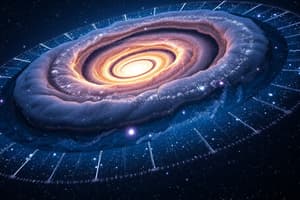Podcast
Questions and Answers
What does the steady-state theory propose about the universe?
What does the steady-state theory propose about the universe?
The universe has always been expanding and matter is constantly created as it expands.
According to the steady-state theory, the universe has a beginning and an end.
According to the steady-state theory, the universe has a beginning and an end.
False (B)
Who proposed the steady-state theory in 1948?
Who proposed the steady-state theory in 1948?
- Hermann Bondi (correct)
- Richard Tolman
- Stephen Hawking
- Albert Einstein
What is the oscillating universe theory also known as?
What is the oscillating universe theory also known as?
Who is the proponent of the oscillating universe theory?
Who is the proponent of the oscillating universe theory?
What happens to the universe according to the oscillating universe theory after all energy from the big bang is used?
What happens to the universe according to the oscillating universe theory after all energy from the big bang is used?
The oscillating universe theory is compatible with the existence of dark energy.
The oscillating universe theory is compatible with the existence of dark energy.
Study Notes
Steady-State Theory
- Proposes that the universe has always been expanding, continuously creating matter.
- As the universe expands, new stars and galaxies form at the same rate as old ones become unobservable.
- Maintains average density despite continuous expansion; hence "steady state."
- Asserts that the universe has no beginning or end and always appears the same throughout time and space.
- Proposed in 1948 by Hermann Bondi, Thomas Gold, and Fred Hoyle.
Oscillating Universe Theory
- Also known as pulsating theory, suggests the universe expands and then contracts after energy from the Big Bang is exhausted.
- The cycle involves expansion leading to a "Big Crunch," which results in a singularity.
- Following singularity, a new universe is born from a "Big Bang"—referred to as the "Big Bounce."
- Proposed by Richard Tolman, a professor at Caltech.
Big Crunch and Big Bang
- Big Crunch occurs when the universe reverses after full expansion, leading to collapse.
- Singularity marks the birth of a new universe through a new Big Bang.
Drawbacks of the Theories
- Oscillating Universe Theory's premise of self-collapse contradicts current physical laws, particularly regarding dark energy.
- Current theories suggest the universe may end through a Big Freeze or heat death rather than contraction.
Studying That Suits You
Use AI to generate personalized quizzes and flashcards to suit your learning preferences.
Related Documents
Description
Explore the concepts of Steady-State Theory and Oscillating Universe Theory in this engaging quiz. Understand how these theories propose the universe's expansion and star formation. Test your knowledge on cosmic evolution with challenging questions.



